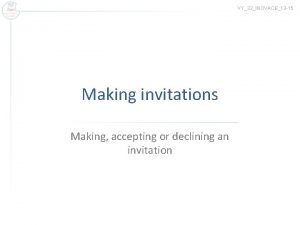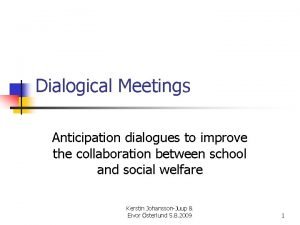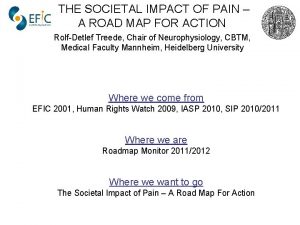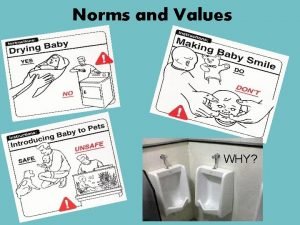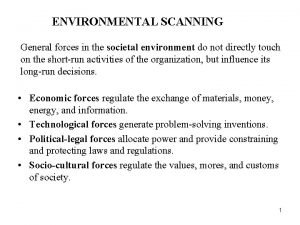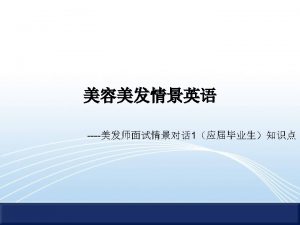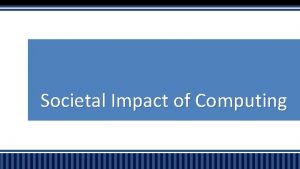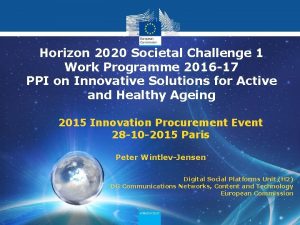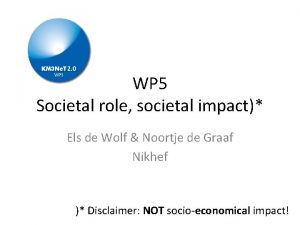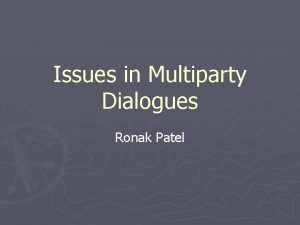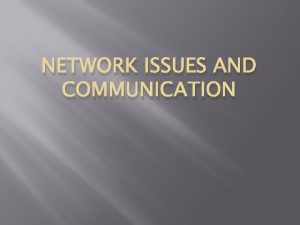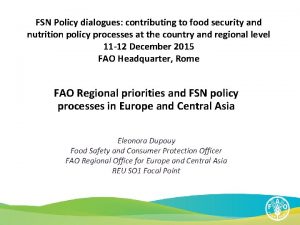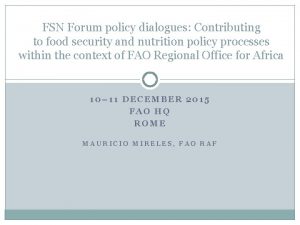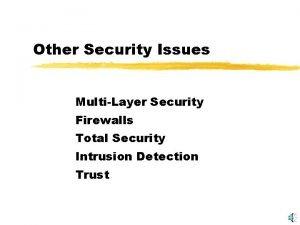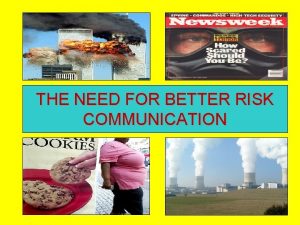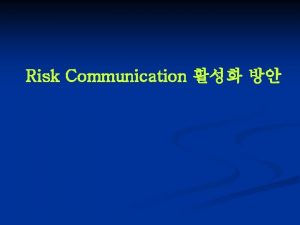Societal Security Risk communication Dialogues on risk issues





























- Slides: 29

Societal Security – Risk communication – Dialogues on risk issues Professor Jørn Vatn, NTNU 1

Topic for reflection n Does a true objective risk exist? n Under which conditions does it make sense to introduce the concept of a true objective risk? n Is the main objective of risk communication to contribute to making perceived risk equal to the true objective risk? n How could decisions be made in a societal security context with a basis in n An objective risk picture n A perceived risk picture that are not consistent? 2

The challenge of the idea of a true risk picture n The idea of a true risk picture, will in most cases lead to a discussion on what is the uncertainty in the risk analysis n “We do not believe in numbers” n In contrast to “numbers are used to express uncertainty related to our concerns” n Adding “uncertainty” to the risk in the meaning that we do not believe in the analysis, is extremely difficult in risk communication n A more direct approach where focus is uncertainty regarding whether accident will happen, and how serious they are is reccomeded 3

Risk communication - Dialogue processes n Main objective n Obtain concerns regarding the analysis object among stakeholders n Structure this wrt n Dimensions to take into account in the risk analysis n Factors to take into account in the risk analysis n Present the risk picture such that the main concerns are reflected in the risk picture (established by accepted risk analysis methods), and presented in an understandable manner 4

4 domains as a basis for risk definition n Real world domain n Observables such as number of gas leakages next year n Scientific cause and effect domain n What is the relation between the observables, which theories exists? n We do not claim to possess true knowledge in this domain n Uncertainty domain (we do not know with certainty) n Lack of sure (certain) knowledge regarding future values of observables, current values of observables, and cause & effects n Value and preferences domain n How desirable the various outcomes in the real world are 5

What is risk? n Conceptual definition: n risk is to be understood as the uncertainty regarding the occurrence and the severity of events n Operational definition (expressing uncertainty) n R = {<ei, pi, Si>} n ei = undesired events n pi, = an expression of the uncertainty regarding occurrence of events, i. e. , probability statements are the quantitative language to express uncertainty (not an inherent property of the system) n Si = Severity of the event, also uncertain, i. e. , we need probability statements to express Si 6

The issue of conditional risk n A risk statement is never unconditional, it should reflect many aspects n U = the relevant information, theories, the understanding, the assumptions etc. which are the basis for the risk assessor when risk is assessed n D = the result of dialog processes and risk communication processes conducted in order to agree upon which elements of severity to focus on (e. g. , fatality rate vs gross accidents) “Ambiguity” n V = the result of the verification processes to verify the correctness of the assessment given U and D n R = {<ei, pi, Si>} | D, U, V n Be as explicit as possible regarding D, U, V 7

Background case study n The local energy provider Lyse was developing an LNG (liquefied natural gas) facility at Risavika outside Stavanger in Norway n Natural gas from the North Sea is transported through pipelines to shore, and then being liquefied at a process plant before it is stored in a huge tank n The LNG is distributed from the facility to local consumers by LNG tankers and LNG lorries n The localisation of the plant has been a hot issue in the region 10

Localization of the LNG factory 11

Project history n The LNG plant is under construction on a dismantled yard of a refinery n The yard was deregulated for new industry and several other enterprises are also under development, including a foreign ferry terminal approx 300 meters from the LNG plant n The LNG facility was approved according to the development plan by the local authorities in June 2006 n The authorization to store and treat inflammable goods was given by the national directorate (DSB) in December 2007 based on a preliminary risk analysis n In order to obtain the final authorization from DSB updated risk analyses have to be provided showing that the risk of the facility as built is in accordance to the acceptance criteria n SINTEF/NTNU engaged to assist on risk communication n A first quantitative update of the risk analysis is available 2008 n There is significant resistance against the factory, and it has been claimed that more or less all central actors have committed serious mistakes in the approval process (Vinnem, 2008) n Test production started in 2010 n The plant was official opened in October 2011 12

Risk communication approach (SINTEF/NTNU) 1. Mass meeting to inform about the process to come 2. Invitation to participate in focus groups 3. 4 -5 focus groups representing different stakeholders n What are threat scenarios, and what could be done to counteract these (measures) 4. A second meeting where one representative for each stakeholder group meet to discuss the findings in the groups 5. The findings from the dialogue meetings are important input to the risk analysis, i. e. , D and U 6. The presentation of the risk picture in subsequent mass meeting(s) reflects (i) the concerns, (ii) how it is assessed, and (iii) the impact on the risk picture 13

Risk analysis Mass meeting Dialogue groups n Purpose of the dialogue groups n Express concern n Bring forward factors affecting risk n Advocate decision criteria and what to focus on, D n Issues that came up n Maintenance can not be guaranteed since DSB (safety authority) is considered much weaker than PTIL (authority in the oil&gas) n Be explicit on worst case n RAC should be replaced by worst case consideration n Risk analysis n The concerns and risk factors were included in the considerations n The risk picture presented aimed to reflect these concerns D/U n Presenting worst case scenarios was appreciated by some of the strongest opponents 14

Topic 1 – Risk acceptance criteria n In Norway it is common that the enterprises themselves establish risk acceptance criteria (RAC) n Criteria are set both for individual risk for various groups, and for societal risk n This is the case even for third person n Safety authorities gives final approval, but do not give recommendations on RAC n For the particular case in Risavika, societal risk was one of the most demanding issues 15

Societal risk acceptance criteria used 16

Avoid «strange» number formatting 17

How reasonable are the RAC? n The RAC are in accordance with values recommended by the HSE in the UK n Similar RAC in the Netherlands are much stricter n How does the RAC relate to “historical” gross accident risk level in Norway? 18

Historical “risk” 19

Criteria used in the Netherlands 20

Conclusions, RAC n In relation to “historical” events, the applied RAC do not impose significant additional risk n Provided not too many enterprises are balancing on the edge between red and yellow n It is not obvious that “natural events” should be used as a basis n However, it is hard to argue that the criteria are unreasonable n The Dutch criteria are much stricter n Note the history of the Dutch criteria: A calibration was done to give a reasonable risk level for 2000 LPG stations in the Netherlands 21

Should one use RAC? n The way RAC were used, the decision problem is seen as a decision problem where one accept any severity level if the assigned probability is sufficient low n Some of the stakeholders claimed that this is not the correct focus, there are some consequences that are unacceptable independent of their probabilities n This calls for a deterministic approach (Perrow? ) n Regulations in Norway does not support such ideas n The topic was indeed discussed during the dialogue meetings, and the mass meetings n This may relate to what Aven & Renn denotes ambiguity 22

Topic 2 - Results from quantitative risk analysis n The results from the QRA shows that the risk is in the ALARP region n The main contributor to the risk is the ferry terminal n An ALARP process has been run to obtain efficient risk reducing measures n The decided risk reduction measures will not bring risk to the Dutch level 23

Topic 3 - Additional risk reducing measure n A drifting gas cloud is the main contributor to gross accident risk n A remote operated fire water pump that can establish a “curtain” of water that may stop the drifting of LNG gas n Forced ignition of drifting LNG gas 24

The plant layout 25

ALARP process n In the ALARP region we should implement all possible risk reducing measure unless they are impractical, or the cost of the measure is disproportional to the risk reducing effect n For the fire pump to produce the protective “curtain” of water, the benefit/cost ratio is found to be approximate 1: 30, hence it may be argued that this is a rather costly measure 26

Forced ignition of the gas cloud n If there is a huge gas leakage at the plant, it is a possibility that the gas will not ignite immediately n Thus, a gas cloud may drift away from the plant towards the ferry terminal 300 metres away n If the gas cloud ignite when passing the ferry terminal this could cause up to 1000 fatalities n In order to reduce the consequence of this scenario it is proposed to ignite the gas cloud intentionally before it reaches the terminal building n This measure was rejected by Lyse 27

Effect of the measure n The measure may reduce the probability of an accident with 1000 fatalities with one or two decades depending on the reliability of the ignition unit n Hence, the measure will bring the risk in the direction of the Dutch criteria n Negative aspects: n Personnel fighting against the leakage will be exposed to an additional risk demanding ethical issue n Increased expected material damages because ignition will for sure make huge material damages, whereas a non ignited gas cloud may drift away without any damage 28

Risk communication: Forced ignition n Forced ignition is a measure that was considered to reduce the risk with an order of magnitude or more n Not recommended by Lyse (i. e. , Scangass AS) n The measure was proposed from one of the stakeholder groups n The measure was serious evaluated n One of the public critic of the plant (Norwegian risk analyst) used the following term in a feature article: n The plant is so “risky” that one has to implement such a dramatic measure n He did not claim: To approach the ALARP region all measures were considered…. 29

LNG leak in Risavika, 2014 (preventor. no) n The 130 kg LNG leak in early May 2014 from the ferry bunkering facility revealed severe faults, and confirm a lot of the criticism made by Prof Vinnem and others over the years. The main deficiencies according to DSB: n ESD system did not function as specified, isolation took too long time n It could not be documented that operators had required competence, nor had been given relevant training in order to conduct bunkering in a safe manner n It could not be documented that risk assessment had been conducted before deviations from procedures were decided n The fire brigade was never informed about the leak. 30

Thank you for your attention Questions? 31
 Legal and ethical issues in media
Legal and ethical issues in media Legal and ethical issues in computer security
Legal and ethical issues in computer security Private security
Private security Expressing likes and dislikes
Expressing likes and dislikes Verb to be dialogue
Verb to be dialogue Designing interfaces and dialogues
Designing interfaces and dialogues Expression of asking and giving permission
Expression of asking and giving permission Introduction conversation in english
Introduction conversation in english Phrases for making suggestions
Phrases for making suggestions English conversation 5
English conversation 5 Declining invitation dialogue
Declining invitation dialogue On the phone dialogue
On the phone dialogue Activity 5 bahasa inggris kelas 11 semester 1
Activity 5 bahasa inggris kelas 11 semester 1 Ponctuation des dialogues
Ponctuation des dialogues Dialog job interview
Dialog job interview Listen to the dialogues match two words
Listen to the dialogues match two words Listen to the short dialogues to fill in the blanks
Listen to the short dialogues to fill in the blanks Expressing sympathy dialogues
Expressing sympathy dialogues Dialogues
Dialogues Practise the dialogue
Practise the dialogue Dialogue example
Dialogue example Dialogues on the road
Dialogues on the road Role play dialogues
Role play dialogues Husker dialogues
Husker dialogues Credit risk market risk operational risk
Credit risk market risk operational risk Societal impact of pain
Societal impact of pain Three considerations of societal marketing concept
Three considerations of societal marketing concept Norms vs values
Norms vs values Individual bilingualism example
Individual bilingualism example All forces in the societal environment
All forces in the societal environment










